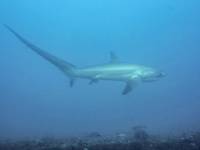 Thresher sharks are large lamniform sharks of the family Alopiidae found in all temperate and tropical oceans of the world. Although occasionally sighted in shallow, inshore waters, thresher sharks are primarily pelagic; they prefer the open ocean, venturing no deeper than 500 metres (1,600 ft). Common threshers tend to be more common in coastal waters over continental shelves. Common thresher sharks are found along the continental shelves of North America and Asia of the North Pacific, but are rare in the Central and Western Pacific. Named for and easily recognised by their exceptionally long, thresher-like tail or caudal fins (which can be as long as the total body length), thresher sharks are active predators; the tail is actually used as a weapon to stun prey. The thresher shark has a short head and a cone shaped nose. The mouth is generally small, and the teeth range in size from small to large. Alopias vulpinus, which may reach a length of 6.1 metres (20 ft) and a weight of over 500 kilograms (1,100 lb). Thresher sharks are fairly slender, with small dorsal fins and large, recurved pectoral fins. Coloration ranges from brownish, bluish or purplish gray dorsally with lighter shades ventrally. The three species can be roughly distinguished by the main color of the dorsal surface of the body. Common threshers are dark green, bigeye threshers are brown and pelagic threshers are generally blue.
Thresher sharks are large lamniform sharks of the family Alopiidae found in all temperate and tropical oceans of the world. Although occasionally sighted in shallow, inshore waters, thresher sharks are primarily pelagic; they prefer the open ocean, venturing no deeper than 500 metres (1,600 ft). Common threshers tend to be more common in coastal waters over continental shelves. Common thresher sharks are found along the continental shelves of North America and Asia of the North Pacific, but are rare in the Central and Western Pacific. Named for and easily recognised by their exceptionally long, thresher-like tail or caudal fins (which can be as long as the total body length), thresher sharks are active predators; the tail is actually used as a weapon to stun prey. The thresher shark has a short head and a cone shaped nose. The mouth is generally small, and the teeth range in size from small to large. Alopias vulpinus, which may reach a length of 6.1 metres (20 ft) and a weight of over 500 kilograms (1,100 lb). Thresher sharks are fairly slender, with small dorsal fins and large, recurved pectoral fins. Coloration ranges from brownish, bluish or purplish gray dorsally with lighter shades ventrally. The three species can be roughly distinguished by the main color of the dorsal surface of the body. Common threshers are dark green, bigeye threshers are brown and pelagic threshers are generally blue.
